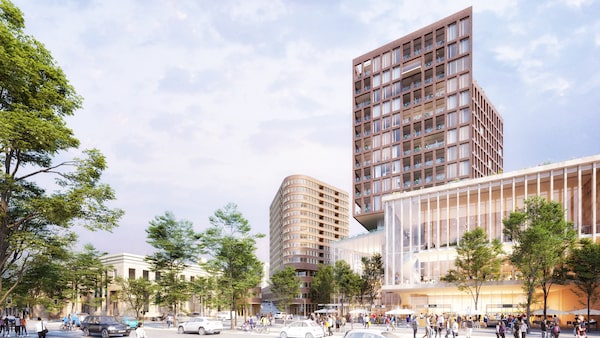
Proposed rendering of the 500,000-square-foot Baker District project in Guelph, budgeted at around $350-million.Handout
The proposed Baker District development in downtown Guelph, Ont., is doing the opposite of Joni Mitchell’s lyrics in Big Yellow Taxi by replacing a paved parking lot and putting up a bit of urban paradise. The plan includes a new library, residences, commercial and institutional space and a market square designed to showcase local food producers.
The 500,000-square-foot project, budgeted at around $350-million, is a joint venture between the city and Ottawa-based Windmill Development Group, that applies sustainability principles for energy efficiency and minimal environmental impact.
About one-third of the funding is public and the rest private, says Jonathan Westeinde, Windmill’s chief executive officer. The project, which will also include about 300 housing units, is within walking distance from Guelph’s train station, which also serves Ontario’s GO commuter routes.
Construction is planned to begin in 2021 and to be completed in 2025. The project will be anchored by a 70,000- to 80,000-square-foot municipal library, designed by Toronto’s Diamond Schmitt Architects, two residential towers and additional commercial/institutional space.
“After three decades of false starts, we finally have a plan to move forward with an elegant new main library in the centre of the city,” says Scott Butler, chair of Guelph’s library board.
“As in other cities, the new library will be a driver for economic development,” Mr. Butler says. There will still be some parking, but the centrally located site will no longer be dominated by a parking lot.

The proposed design of the project includes about 300 housing units.Handout
It’s also aiming to be a 21st-century environmental harbinger. Baker District is one of the only projects in Canada to be endorsed as a One Planet Living development. Another one, a community called Zibi, is in Ottawa.
Established in Britain in 2003, the not-for-profit One Planet Living organization issues its seal of approval and provides advice to developments that aim to be built and maintained without overusing the Earth’s finite, limited resources.
The city and One Planet are hoping the project will abide by criteria designed to cope with the worldwide climate emergency and the need to live sustainably with what’s left of the world’s resources.
“There’s an immediate need to change how we build,” says Jenny McMinn, managing director of Urban Equation, consultants who are working with Guelph to put together the One Planet plan for the district.
“In North America we’re using far more resources than our planet can sustain,” she says.
The city notes on its own website: “Research has shown that if everyone lived like North Americans, we would need five planets’ worth of resources to support ourselves. We only have one planet and need to act accordingly.”
The term “sustainable development” was coined by a United Nations commission back in the 1980s; today, building a sustainable community involves looking not only at the resources, but also how people interact with what’s built, Ms. McMinn says.

The proposed design is walking distance from Guelph’s train station.Handout
“One Planet considers how we live and how we consume,” she says. “For Baker District and Guelph, that means looking at the food people consume. Food is an obvious focus for this project.”
Her hope is that local food producers, retailers and the University of Guelph have a presence on the site.
“The roof of the library might be an ideal place to grow food,” she suggests, adding that exploring such aspects in the earlier planning stages is key.
“That way, they become part of the design and not an add-on.”
Though it’s located less than 100 kilometres from Toronto, Guelph is in the heart of a rich farm belt, and the university is home to the internationally recognized Ontario Agricultural College.

Guelph's Baker District, proposed rendering seen here, is one of the only projects in Canada to be endorsed as a One Planet Living development.Handout
Guelph has also been carving out a niche as an environmentally conscious city since the 1980s, and it’s the seat of Ontario’s only Green Party MPP, Mike Schreiner, who is also the provincial party’s leader.
“The Baker District redevelopment is a good example of what a green recovery can achieve,” says Mr. Schreiner.
“We can reshape our neighbourhoods to make it easier to get around, focus on sustainability, while creating jobs,” he says. “I’m excited to see projects that lessen our impact on our planet, promote healthier lifestyles and strengthen local economies.”
“We’re trying to create diversity in the traffic that comes into the area and reduce the project’s carbon imprint,” says Mr. Westeinde. Windmill is working with the city to look at how much and the ways in which carbon is produced and used on the site, in construction and once it is built.
“We’re looking at how to lower the carbon footprint, for example, by having amenities within walking distance and [creating] a circular food economy within the development,” he says. A circular food economy includes making locally grown produce easily available.
“We’re working with One Planet because it’s a framework that covers the whole spectrum of ESG – environmental, social and governance impact,” Mr. Westeinde adds.
ESG principles are being embraced and adapted as make-or-break decision-making factors by investors, lenders, corporate boards and governments as the world turns its attention to the growing climate emergency. The Organization for Economic Co-operation and Development noted in its 2020 outlook that investors “consider ESG-related information increasingly important to determine whether a company is adequately managing risk and aligning its strategy to achieve long-term returns.”

The project applies sustainability principles for energy efficiency and minimal environmental impact.Handout
The economic effect on Guelph’s downtown core is also significant, says Will Mactaggart, a Guelph investment adviser and chair of the Downtown Guelph Business Association.
“It’s a boon for downtown Guelph, especially after the year we’ve had,” he says, referring to COVID-19. His association aims to leverage the new downtown infrastructure to attract and keep business and people in the city’s core.
Applying sustainability principles to new development is important not just for the environment, but to keep cities alive, adds library chair Mr. Butler. “Communities the size of Guelph [about 135,000 people] struggle to keep downtowns vibrant and a development like this, with the library, sends a signal to businesses that this is a good place to invest,” he says.
“Whether it’s fate, good design or sheer luck, we’re at a point where we have a world-class food institute [at the university] with a developer who wants to focus on urban agriculture – and a new library. It’s a once-in-a-lifetime opportunity to do something grand.”